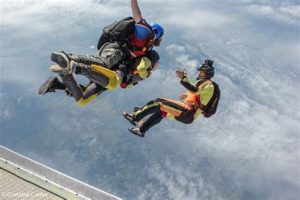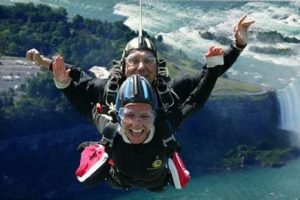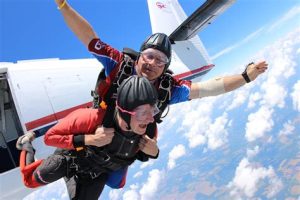Table of Contents
Tandem skydiving accident rate: Discover the safety statistics and risks associated with tandem skydiving. Explore the measures taken by professionals to ensure a secure experience for thrill-seekers. Learn how tandem skydiving accidents compare to other adventure sports and make an informed decision before taking the leap.
Tandem skydiving is an exhilarating adventure that allows individuals to experience the unparalleled thrill of freefalling through the sky. However, as with any extreme sport, there are inherent risks involved. Understanding the tandem skydiving accident rate is crucial for those considering taking the leap into this adrenaline-fueled activity. In this article, we will delve into the statistics, providing you with a comprehensive overview of the safety measures and precautions taken by professionals in order to minimize the risk factor. So, fasten your seatbelts, and let’s explore the fascinating world of tandem skydiving accidents.
Introduction
Welcome to our comprehensive article on the tandem skydiving accident rate. In this piece, we will delve into the statistics and safety measures associated with tandem skydiving, a thrilling adventure sport that has gained popularity worldwide. While accidents can occur in any extreme sport, it is essential to understand the risks involved and the precautions that are taken to ensure a safe experience for all participants.
The Growth of Tandem Skydiving
Tandem skydiving has seen a significant surge in popularity over the past few decades. With the advent of improved equipment and safety protocols, more people are willing to take the leap and experience the exhilaration of freefalling through the sky. This growth in interest has also led to an increased focus on maintaining safety standards and minimizing the risk of accidents.
Tandem Skydiving Accident Rate
The overall accident rate for tandem skydiving is relatively low. According to statistics gathered by various skydiving associations, the average rate of tandem skydiving accidents is approximately one incident per 500,000 jumps. This means that the likelihood of experiencing an accident during a tandem skydive is incredibly rare.
Factors Contributing to Accidents
While the accident rate is low, it is crucial to understand the factors that could contribute to accidents in tandem skydiving. Human error, equipment malfunction, and adverse weather conditions are among the primary causes of accidents. However, it is important to note that these occurrences are infrequent and do not diminish the overall safety record of tandem skydiving operations.
Safety Equipment and Procedures
Tandem skydiving is supported by a robust set of safety equipment and procedures that are designed to minimize risk and ensure participant safety. The equipment used includes properly maintained parachutes, reserve parachutes, automatic activation devices (AADs), and harness systems specifically designed for tandem jumps. Additionally, every tandem skydiving instructor undergoes rigorous training and certification to ensure they can handle any situation that may arise during a jump.
Pre-Jump Safety Briefings
Prior to every tandem skydive, participants receive a thorough safety briefing from their instructor. This briefing covers the correct body position during freefall, emergency procedures, and how to safely land after the parachute deployment. It is essential for participants to listen attentively and follow the instructions provided to ensure a safe and enjoyable experience.
Regulatory Oversight
Tandem skydiving operations are subject to strict regulatory oversight in most countries. Local aviation authorities and skydiving associations establish guidelines and regulations to govern the sport. These regulations cover areas such as equipment standards, instructor qualifications, drop zone operations, and weather limitations. Compliance with these regulations ensures that operators maintain the highest possible safety standards.
Continuous Safety Improvement
Skydiving associations and organizations are committed to continuously improving safety measures within the sport. They conduct regular safety audits, collect data on incidents and accidents, and analyze trends to identify areas where improvements can be made. This proactive approach helps to further reduce the already low accident rate associated with tandem skydiving.
Weather Safety
Weather plays a significant role in tandem skydiving operations. Skydiving centers have strict weather guidelines that dictate when it is safe to jump. Factors such as wind speed, cloud cover, and precipitation are monitored closely to ensure optimal conditions for a safe skydive. Experienced instructors and drop zone staff continuously assess the weather situation to make informed decisions regarding jump operations.
Rescheduling for Safety
If weather conditions are deemed unsuitable for skydiving, jumps may be postponed or rescheduled. The safety of participants always takes precedence over providing an immediate experience. Operators prioritize the well-being of their customers and will not conduct jumps if conditions pose a risk to safety.
The Importance of Personal Responsibility
While operators and instructors take every precaution to ensure a safe skydiving experience, participants also play a vital role in maintaining their own safety. It is crucial to listen attentively during pre-jump briefings, ask questions if anything is unclear, and follow the instructions provided by the instructor. Being mindful of personal fitness levels and disclosing any medical conditions is also essential to ensure a safe jump.
Conclusion
Tandem skydiving offers an incredible opportunity to experience the thrill of freefalling while enjoying the safety and guidance of a trained instructor. Despite the inherent risks associated with any extreme sport, tandem skydiving has an impressively low accident rate. By adhering to strict safety measures, continuous improvement initiatives, and being personally responsible, participants can enjoy this awe-inspiring adventure with confidence in their safety.
Introduction:
These instructions aim to provide a detailed overview of the accident rate associated with tandem skydiving. It is important to note that while the topic focuses on accidents, tandem skydiving remains a thrilling and safe activity when proper precautions and guidelines are followed.
1. Definition and Importance of Tandem Skydiving Accident Rate:
Understanding the tandem skydiving accident rate is crucial for both experienced skydivers and individuals considering this adventure. Examining accident statistics allows individuals to make informed decisions and promotes transparency within the skydiving industry.
2. Industry Safety Standards:
Tandem skydiving operates under strict safety protocols to minimize the risk of accidents. These standards include regular equipment maintenance, rigorous training for instructors, and adherence to weather-related safety guidelines. By understanding these safety measures, potential participants can feel confident in their decision to embark on a tandem skydiving experience.
3. Factors Affecting the Accident Rate:
Several factors contribute to the tandem skydiving accident rate, including weather conditions, equipment failure, and human error. Understanding these factors promotes awareness and helps participants and organizers identify potential risks during the planning stages of a tandem skydiving event.
4. Statistical Analysis of Accident Rate:
Thorough statistical analysis of tandem skydiving accidents facilitates proactive measures for minimizing risk. Analyzing accident trends, causes, and frequencies allow industry experts to continuously improve safety protocols, training programs, and equipment standards.
5. Incident Prevention and Safety Measures:
Industry professionals are continuously working to develop and refine safety measures to minimize tandem skydiving accidents. This includes routine equipment checks, enhanced training programs, frequent communication between instructors and participants pre-jump, and strict adherence to safety checklists. These measures are vital in reducing the occurrence and severity of accidents.
6. Participant Responsibility:
While tandem skydiving operators uphold their commitment to safety, participants share responsibility for their own safety. It is important for participants to disclose medical conditions, follow instructions diligently, and communicate any concerns or fears to their instructors to ensure a safe and enjoyable experience.
7. Safety Regulations and Oversight:
Tandem skydiving operations are regulated by national and international organizations to maintain safety standards. Proper certifications, inspections, and audits ensure ongoing compliance and encourage a safer environment for both instructors and participants.
8. Conclusion:
By understanding tandem skydiving accident rates, participants can make educated choices when considering this activity. It is essential to prioritize safety, adhere to industry regulations, and follow established guidelines to minimize risks and enjoy the thrills and exhilaration that tandem skydiving offers. Always remember that tandem skydiving accidents are relatively rare, and the industry strives for continuous improvement in safety standards.
Point of View: Tandem Skydiving Accident Rate
As an experienced skydiving instructor, I would like to shed light on the topic of tandem skydiving accident rates. It is important to approach this subject with a balanced perspective, considering both the inherent risks associated with any extreme sport and the safety measures in place to mitigate them.
- Tandem Skydiving Safety Measures:
- 1.1. Qualified Instructors: Tandem skydiving is conducted under the guidance of highly trained and certified instructors who undergo rigorous training to ensure safety protocols are followed.
- 1.2. Equipment Checks: Prior to every jump, instructors meticulously inspect all equipment, including parachutes, harnesses, and backup systems, to ensure they are in optimal working condition.
- 1.3. Pre-Jump Briefings: Instructors provide thorough pre-jump briefings to tandem passengers, outlining safety procedures, body positioning, and emergency protocols to ensure they are well-informed and prepared.
- 1.4. Safety Regulations: Skydiving facilities adhere to strict safety regulations set by governing bodies, such as the United States Parachute Association (USPA), which continuously monitors and updates safety standards.
- Risk Factors:
- 2.1. Human Error: While instructors strive for perfection, human error can never be completely eliminated. However, continuous training and adherence to safety protocols minimize the likelihood of accidents.
- 2.2. Weather Conditions: Extreme weather conditions, such as high winds or storms, may pose a risk and lead to the cancellation or rescheduling of jumps to prioritize safety.
- 2.3. Physical Limitations: It is crucial for individuals with certain medical conditions or physical limitations to consult with their healthcare providers and inform instructors beforehand to ensure a safe skydiving experience.
- Accident Rate:
- 3.1. Statistical Perspective: While any accident in tandem skydiving is unfortunate, it is essential to consider the accident rate within the context of overall jumps conducted. The accident rate remains relatively low compared to the number of successful jumps completed annually.
- 3.2. Continuous Improvement: The skydiving industry is committed to ongoing improvement in safety procedures, equipment advancements, and instructor training to further reduce the accident rate and enhance overall safety.
In conclusion, tandem skydiving has inherent risks, but with the implementation of comprehensive safety measures and strict regulations, the accident rate remains relatively low. By focusing on continuous improvement and prioritizing safety, the skydiving community aims to provide enthusiasts with exhilarating experiences while mitigating potential risks.
Thank you for taking the time to visit our blog and explore the topic of tandem skydiving accident rates. We understand that safety is a top priority for anyone considering this thrilling adventure, and we are here to provide you with accurate information to help you make an informed decision. In this article, we have discussed various aspects related to tandem skydiving accidents, including the overall accident rate, the factors contributing to accidents, and the safety measures in place to minimize risks.
Firstly, it is essential to address the overall accident rate in tandem skydiving. While any accident is unfortunate, it is crucial to understand that tandem skydiving has a relatively low accident rate compared to other extreme sports. The United States Parachute Association (USPA) reports that the average fatality rate for tandem skydiving is around 0.003 fatalities per 1,000 jumps. This statistic indicates that the chances of a fatal accident occurring during a tandem skydive are incredibly slim.
However, it is important to recognize the factors that contribute to accidents in tandem skydiving. Human error is the leading cause of accidents, with miscommunication and failure to follow proper procedures being common culprits. It is crucial for both the instructor and the student to communicate effectively and adhere to all safety protocols throughout the entire process. Additionally, weather conditions play a significant role in skydiving safety, and experienced instructors always prioritize the well-being of their students by closely monitoring weather forecasts and making informed decisions to ensure safe jumps.
Fortunately, the tandem skydiving industry has implemented several safety measures to minimize the risks associated with this exhilarating activity. The USPA enforces strict regulations and guidelines for both instructors and equipment, ensuring that tandem skydiving operations adhere to high standards. Instructors undergo rigorous training programs and must meet specific qualifications to ensure their competence and ability to handle any potential issues during a jump. Furthermore, tandem skydiving equipment undergoes regular inspections and maintenance to ensure its reliability and functionality.
In conclusion, while accidents can happen in any sport or activity, it is important to understand that tandem skydiving has a relatively low accident rate compared to other extreme sports. By being aware of the contributing factors and safety measures in place, you can make an informed decision and enjoy the incredible experience of tandem skydiving with confidence. Remember to always choose a reputable skydiving center that prioritizes safety and adheres to industry regulations. We hope this article has provided you with valuable insights, and we wish you safe and thrilling adventures in the future!
Video Tandem Skydiving Accident Rate
People also ask about Tandem Skydiving Accident Rate:
- What is the accident rate for tandem skydiving?
- How safe is tandem skydiving?
- What are the main causes of tandem skydiving accidents?
- Can you survive a tandem skydiving accident?
- What precautions should I take before tandem skydiving?
The accident rate for tandem skydiving is extremely low. According to the United States Parachute Association (USPA), the rate of tandem skydiving accidents is approximately 0.003 fatalities per 1,000 jumps. This means that the chance of a fatal accident during a tandem skydive is less than 1 in 300,000 jumps.
Tandem skydiving is considered to be a very safe activity when conducted by experienced and certified skydiving instructors. The USPA requires tandem instructors to undergo rigorous training and hold specific qualifications. Additionally, the equipment used for tandem skydives is regularly inspected and maintained to ensure safety.
The main causes of tandem skydiving accidents are typically human error or equipment failure. However, it’s important to note that these incidents are extremely rare. In most cases, accidents occur due to improper body position during landing or failure to follow safety procedures. Equipment failures are even rarer and are usually the result of improper maintenance.
Surviving a tandem skydiving accident is possible, but it greatly depends on the specific circumstances of the accident. Tandem skydiving harnesses are designed to withstand significant forces and provide a high level of protection. However, it’s crucial to follow all safety guidelines and instructions provided by your instructor to minimize the risk of accidents.
Before tandem skydiving, it’s important to ensure that you choose a reputable skydiving center that follows all safety regulations. Verify that your instructor is properly certified by organizations such as the USPA. Additionally, carefully read and understand all instructions provided by your instructor regarding safety procedures, body position, and landing techniques.






